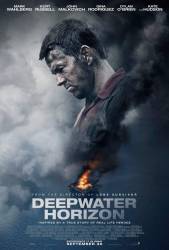Question: Why did Vidrine not think there was anything wrong with the drill pipe, even though the drill pipe test showed a lot of pressure? Second, why did the test on the kill line show no pressure?

Deepwater Horizon (2016)
1 commented-on entry since 15 Apr '21, 15:59
Directed by: Peter Berg
Starring: Mark Wahlberg, Kurt Russell, Kate Hudson, Dylan O'Brien
Factual error: Towards the end of the movie when the hotel keys are handed out, they're IHG hotel keys for the Crowne Plaza. When the incident occurred, the cards would have been Priority Club, not IHG. (01:34:10)
Andrea Fleytas: I don't want to die! I don't want to die.
Mike Williams: You're not going to die. Trust me.

Trivia: When Mr. Jimmy is calling out names on the boat to see who's missing, the real Mr. Jimmy Harrell is standing next to him, wearing a dirty grey T-shirt (and presumably playing a random rig worker). You can first see him (from the back) when Russell calls out Caleb Holloway's name. The first view of his face is just as Russell gets out the life raft onto the deck of the rescue ship. (01:28:30)
Question: I have two questions. First, Did the disaster start as shown in the movie? Second, did the explosion look like what we saw in the movie?
Answer: The disaster started as a gas blow-out followed by a massive explosion on the oil rig, visible from 40 miles away. Eleven people were killed. Two days later, the burning rig collapsed into the sea, which severed the wellhead at a depth of over 4000 feet. If anything, the movie underplayed the disaster.
Actually, according to history vs Hollywood the real life explosion was equally as bad as what's shown in the movie.
Join the mailing list
Separate from membership, this is to get updates about mistakes in recent releases. Addresses are not passed on to any third party, and are used solely for direct communication from this site. You can unsubscribe at any time.
Check out the mistake & trivia books, on Kindle and in paperback.




Answer: Vidrine didn't think there was anything wrong with the the drill pipe because there was nothing wrong with it. The problem was the cement cap they tried installing to seal the well. The thing to keep in mind is that British Petroleum didn't intend to immediately tap that well. Managers and crew of the floating platform rig planned to just cap the well and let another rig come along to handle actual production later. The crew was thus a little anxious to cement the well closed and abandon it. Some think it was this anxiousness to move on that produced the blowout. Of many procedures performed prior to abandonment was the "negative test" (whereby drilling mud was pulled out of the well to determine whether the cement cap could withstand the pressure). The negative test was bad, showing pressure in the drill line, an indication that gas had entered the well because they were applying suction to it, and the integrity of the cement cap was compromised. That's when Vidrine ordered the second test, this time on the kill line, and got a reading of no pressure (which was good, but was probably a false reading). Obviously, something wasn't right; but Vidrine, anxious to wrap the operation, decided to trust the kill line reading and basically ignore the drill line reading. This was a major mistake. As they continued pulling the drilling mud out, highly-pressurized gas shot straight up the drill pipe to the rig, and that was the end of Deepwater Horizon.
Charles Austin Miller
In the movie, the reason the kill line got no pressure is because the pipe got clogged. (if you listen to the audio description, you'll hear the audio describer the mud clogs the pipe during the kill line pressure test scene).
I thought it was mud that shot straight up from the drill pipe to the rig.
They were sucking the drilling mud up the pipe, but there was high-pressure petroleum gas behind it. They only realised too late that they had failed to cap the well; and then hell, as they say, broke loose.
Charles Austin Miller
Then what was that fluid flying upward through derrick?
You can liken a gas blow-out to somebody popping the top on a pressurized can of soda; gas and fluid alike come spewing out of what was, a moment before, a fairly stable fluid. Under tremendous pressure, all you need to do is give natural gas an escape route and all kinds of stuff comes up with it, including crude oil, asphalt, drilling mud, water, etc. The gas is blasting out of the earth and carrying anything and everything with it.
Charles Austin Miller
The mud contained a certain methane gas proportion, which ignited and caused the explosions.
Authorities don't think Vidrine was ultimately responsible though. They believe the an employee who died in the disaster was, because he was responsible for the bladder effect hypothesis. I think what the film is actually trying to say is that the person who made the mistake of trusting the kill line was ultimately responsible.
In real life, it was Vidrine who chose to trust the kill line reading and ignore the drill line reading.
Charles Austin Miller
By blaming someone who isn't around to defend themselves as they died in the disaster is considered cowardly. That's why in my opinion, money exchanged hands between BP and the Authorities to ensure no charges were brought against Vidrine. Again that's my own opinion. Here's a link to where the manslaughter charges against Kaluza and Vidrine are dropped https://www.theguardian.com/environment/2015/dec/03/manslaughter-charges-dropped-bp-employees-deepwater-horizon-oil-spill.
Ssiscool ★
Personally I think the idea that the actual villain was the guy who was responsible for the bladder effect hypothesis, and not the guy who chose to trust the kill line reading, and not the drill line reading is absurd.